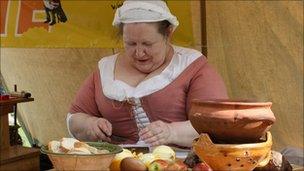Medieval diet aids healthy eating message
- Published

Food historian Caroline Yeldham says the medieval diet was largely a healthy one.
The Horrible Histories series has been a great success in teaching children about the lives of the Romans, Aztecs and Egyptians, among others.
But could history also hold the key to encouraging our children to eat better?
Dr Iona McCleery, a lecturer in medieval history at Leeds University, believes it could help experts tackle the growing childhood obesity problem.
Armed with plastic skeletons, Iona and her team - who are funded by the Wellcome Trust - will be travelling round schools in the Wakefield area of Yorkshire, to teach about the effects of a medieval diet as part of the three-year "you are what you ate" project.
She said: "We will use history to develop a less preachy approach to modern health.
"We'll be asking questions such as 'how do our relatively low activity levels interact with our diet in contrast to soldiers and labourers of past times'?
"This project will completely transform public perceptions of the past. We'll be looking at things like how fruit and vegetables were at one time considered unhealthy and how we used to have a much spicier diet than we do now.
"Through food festival stalls and cooking demonstrations we will also reach people who don't usually go into museums to encourage them to think about how the past affects their own eating habits."
Peasant role models
Dr McCleery, who is working with Wakefield Council and Bradford University's archaeological sciences department, said that, whereas in the past it was the rich who risked weight gain, today poorer people are more more likely to become obese.
"Interestingly it was the peasant class, whose diet would class today as healthy," she said.
"The poorer you were, the higher chances you ate more vegetables and had more mixed grains in your diet.
"The poor were semi-vegetarians who simply could not afford meat and social status. Wealth is very much associated with diet."
Food historian Caroline Yeldham agreed, saying that highlighting modern eating patterns and contrasting them to medieval diets would make people think about what they ate.
"The medieval diet was very fresh food. There were very few preserves so everything was made fresh and it was low in fat and low in salt and sugar."
Meal times were more a family and community focus in medieval times and Caroline said this was a positive force.
"Dining was very ritualised either in the family or household and was a formal activity. People were eating together regularly so although snacking was available, it was not a focus.
"Snacking was much less socially acceptable.
"There are certainly a much wider range of ingredients than we tend to eat today - more herbs and fish, rather than imports which were a small part of the diet and used as flavourings.
"There are some very famous people who became obese such as Henry VIII and Wolsey. But you did not see young people who were obese.
Most food in medieval times was seasonal.
"Medieval people were much more physically active than we are.
"They were like rugby players. When they were very fit and active they used up the calories, but after an injury or illness, that was when their activity level went down and they became obese.
Child health experts at Mend, a programme which aims to encourage obese children to be more healthy, praised the scheme.
"Being creative with food is a great way for children to learn about different foods," they said.
"Looking at what our medieval ancestors ate is an interesting way to get children to think about how their diets differ from their ancestors."
- Published16 July 2010
- Published14 August 2010